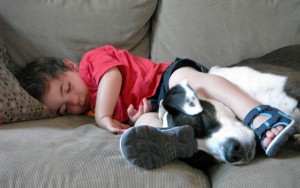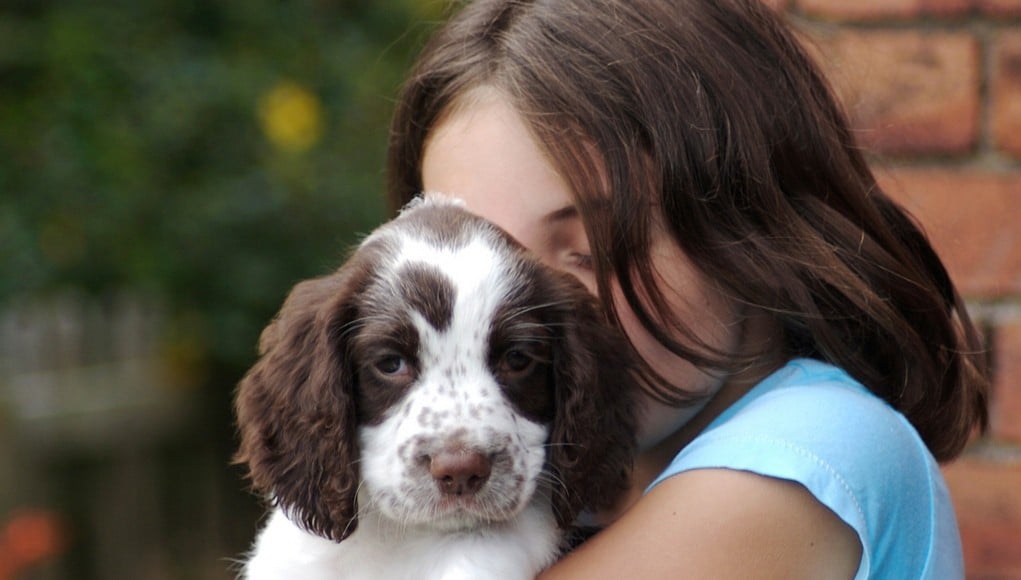We all know what service dogs can do and the immeasurable benefits they offer those of us dealing with physical and mental challenges. But what if the challenges are emotional? I was unfamiliar with animal-assisted therapy until I saw for myself what a dog can do for an abused child.
Animal-assisted therapy is exactly what it sounds like – a type of therapy where animals are used as treatment. Advocates for the treatment believe that animals can be used to better the social, emotional, or cognitive functioning of human beings. Dogs are the most commonly used therapy animals, but horses, cats, birds, and even dolphins have been used to help humans cope with all kinds of different challenges.
Many therapy dogs have been in the news recently because of the benefits that they have provided to our veterans, particularly those suffering from post-traumatic stress disorder (PTSD). Many people don't realize that service dogs are also used with children everyday. Some of these children have been traumatized by the things they've seen in a poor home environment and some are struggling with life in the foster care system.
No matter what issues a child is dealing with mentally, emotionally, or socially, there is a service dog that can help them heal. The benefits of working with one of these special companion animals have been shown time and time again throughout many different circumstances.
The Healing Power of Dogs
My Background in Foster Parenting
I became a foster parent in my mid-30's. My reasons aren’t important, although I will say that I decided not to adopt but instead to continue working with these children who are not only victims of their parents’ abuse but also of a society that has fallen down on its basic duty of protecting its vulnerable members. I’ll get off my soapbox now, but don’t be surprised if I climb right back on.
When I told the foster parent supervisor at the Department of Human Services that I preferred teenagers to younger children, there was a dead silence. I thought perhaps I shouldn’t have expressed a preference. As it turned out, I was only one of two foster parents in the county who preferred teenagers. Most foster parents won’t take them.

RELATED: Essential Dog Products for Dog Owners with Kids
Teenagers have special needs when it comes to the foster care system. For one thing, their self-esteem takes another blow when they come into care. Younger children are placed with foster families more easily and are almost always the first choice when it comes to adoption. A teenager in foster care will probably remain there until they age out of the system. So on top of the abuse they have suffered at home, sometimes for years, these abused teens feel that they aren’t valued.
Abused children are often quite shy and withdrawn and have few if any social skills. They are often far behind in their schoolwork as well. Probably one of the most difficult things to overcome is the child’s homesickness. They miss their parents, no matter how abusive the parents were or how bad the conditions at home.
I assumed at first that a child would be grateful to get out of such a bad situation. I was wrong. When abuse and neglect are all you’ve ever known, even if it’s your parents doing the abusing, you miss them. To the child, their home situation is not bad. It’s their home and their family, and they miss them.
I Witnessed the Healing Power of Dogs
I saw the beneficial effects my dogs could have on these children by accident at first. Of course, I can’t use their names or identify them in any way, but I can tell you their stories.
One of the first children who came to live with me was so afraid of the dark that she couldn’t sleep at night. Nightlights didn’t help, and I would find her up and wandering at all hours. Her social worker suspected that the child’s stepfather had been “visiting” her in the middle of the night. No wonder she was scared of the dark.

She had been with us long enough for me to know that she wasn’t violent and she was always gentle with my dogs, so I felt comfortable suggesting that she let Petey, my cocker spaniel and one of the gentlest dogs I’ve ever had, sleep with her.
RELATED: 35 Best Medium and Small Dogs for Kids
It was no magic pill, of course, but after several nights of Petey standing vigil with her and growling at every sound he heard, I found them both asleep with her arm around him. She still had many sleepless nights, but now she had some good ones too.
Another child was far behind in school. She was 14 years old and reading at a third-grade level. I would read to her at night, both of us on the couch and Petey lying with his head in her lap, but when I suggested she read to me, she refused. Several days later, I found her reading to Petey. It’s easier to read to a non-judgmental animal than to an adult you’re scared may criticize or embarrass you.
Nothing Can Replace Parental Love
Children who have been abused or neglected by their parents, especially their mother either directly or through inaction, don’t have a good model of parental love. The abusive way they’ve been treated is all they’ve ever known and how they assume it should be between parent and child.
One of my children, a 12-year old girl who weighed about 50 pounds when she came to live with me, dearly wanted to return to her mother even though her mother allowed her children to live in unimaginable filth and used this beautiful child to get money.
She had been with me for a month when Chas, my female cocker spaniel, began whelping. I tried to distract her — whelping is not something I think a child should see, despite it being called “the miracle of birth.” After the babies were cleaned up and all were nursing, I brought her in to see the puppies.

She was amazed. You could see it in her eyes. But when she reached out to touch one, Chas growled. Chas’s biggest pleasures were dog treats and playing (in that order), and she had never growled at anyone in her life. I explained that Chas was protecting her babies and that she would protect them from everything, even other things she loved. (Chas would allow me to pick up her babies of course, but I thought adding that to the explanation would only confuse her.)
RELATED: How to Start a Dog Breeding Business
Over the next few weeks, she watched Chas take care of her puppies. I would join her sometimes, and we would sit silently by the whelping box. Occasionally she would comment on something Chas was doing and I would explain it, but for the most part, she just watched. As the puppies got a little older, I would let her hold them one at a time, but Chas was always there, ready to step in if we did something she didn’t like.
We never talked about her mother directly. I think she was hesitant to say anything that might feel disloyal, and I was afraid I wouldn’t be able to keep a neutral tone. But we often talked about Chas and what a good mother she was. There’s nothing more lovable than a six-week-old cocker spaniel puppy, and she watched as all of them grew strong and healthy under their mother’s watchful eye. I think it changed her perception of what a mother’s love is.
Reaping the Rewards
I’ve since used my dogs to get shy kids to interact with other kids, to raise the self-esteem of a child who thinks she can’t do anything right, to comfort sick children, and to learn the advantages of obedience. It’s quite an eye-opener for a child to see a dog wandering off and then immediately stand still at my “stop” command, especially if there’s a car whizzing by. (This was preplanned. My dog was never in any danger.)
I stumbled upon this rewarding use of dogs, but now I try to remain aware of their power when it comes to children. Dogs can heal. It's just that simple. Most dog owners already understand this canine trait because their dog has helped them through a difficult time. The healing power of dogs has been proven many times, and dogs continue to help humans cope with mental, physical, and emotional problems every day.













